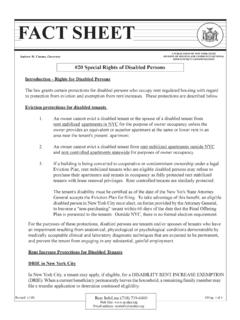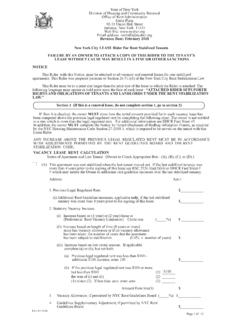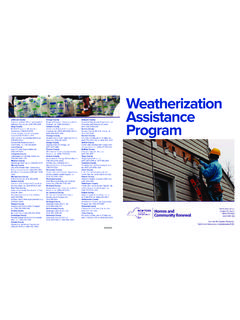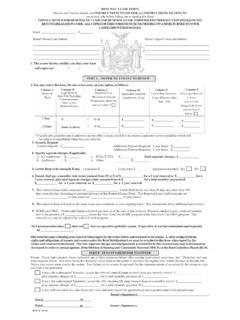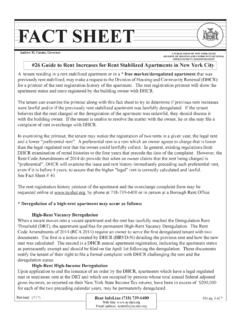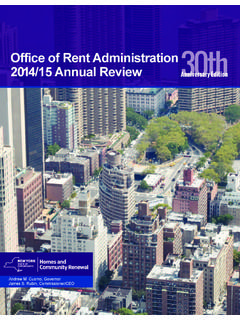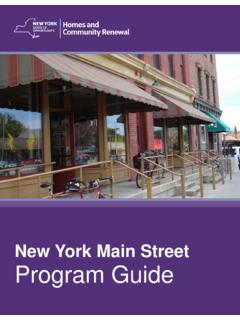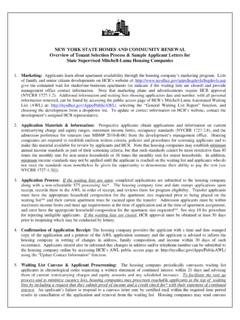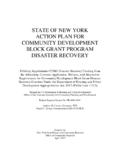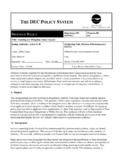Transcription of HOUSING TRUST FUND CORPORATION Environmental …
1 HOUSING TRUST fund CORPORATION Environmental Compliance handbook Office of Community Renewal state funded programs including: Adirondack Community HOUSING TRUST (ACHT) Buffalo Main Streets Initiative (BMSI) OCR Managed Downtown Revitalization Initiative Projects (DRI) New York Main Street Program (NYMS) Rural Area Revitalization Projects Program (RARP) Urban Initiatives Program (UI) _____ Environmental Compliance handbook - Updated July 2018 1 TABLE OF CONTENTS I. INTRODUCTION .. 2 II. Environmental COMPLIANCE PROCESS: STEP BY STEP .. 2 III. COMPLETING THE Environmental COMPLIANCE CHECKLIST .. 5 A. HISTORIC RESOURCES .. 6 B. FLOODPLAIN MANAGEMENT .. 7 C. ZONING .. 10 D. COASTAL ZONE MANAGEMENT .. 11 E. SITE CONTAMINATION (HAZARDOUS MATERIALS) .. 13 F. LEAD-BASED PAINT .. 16 Lead-Based Paint Policy Table .. 19 G. ASBESTOS CONTAINING MATERIALS .. 21 H. RADON .. 22 I. WETLANDS .. 24 J. ENDANGERED SPECIES.
2 25 K. AGRICULTURAL DISTRICTS .. 27 _____ Environmental Compliance handbook - Updated July 2018 2 I. INTRODUCTION Awards made under the Office of Community Renewal s state funded grant programs are subject to requirements of the State Environmental Quality Review Act ( seqr ) at 6 NYCRR Part 617. Compliance applies to all participants in the development process, including public or private nonprofit or for-profit entities, or any of participating contractors. The primary objective of the Environmental review process is to identify specific Environmental factors that may be encountered at individual project sites, and to develop procedures to ensure compliance with regulations pertaining to these factors. Identified Project Sites In cases where individual project sites/buildings have been identified at the time of application and contract execution, the Environmental review process will evaluate site-specific Environmental Compliance Checklist(s).
3 When the review is complete, the Local Program Administrator (LPA) will receive a determination letter from the HOUSING TRUST fund CORPORATION s (HTFC) Environmental Analysis Unit (EAU) specific to the identified projects. Unidentified Project Sites For programs that have not identified individual project sites or streetscape project locations at the time of contract execution, a programmatic Environmental Compliance Checklist must be completed to document the programmatic Environmental review procedures that will apply to projects later selected for participation. When the review of the programmatic Environmental Compliance Checklist is complete, the Local Program Administrator (LPA) will receive a determination letter from the HOUSING TRUST fund CORPORATION s (HTFC) Environmental Analysis Unit (EAU). Following receipt of the determination letter, individual site specific Environmental Compliance Checklists and associated supporting documentation must be submitted to the Office of Community Renewal (OCR) at the time of Project Set up, which is the formal commitment of program funds.
4 HTFC will also review compliance with these procedures as part of the contract monitoring process. Grant activities cannot begin until an Environmental determination letter is received. II. Environmental COMPLIANCE PROCESS: STEP BY STEP The following is a step-by-step process to obtain Environmental clearance and to develop an appropriate set of programmatic Environmental review procedures. All referenced forms can be found online: STEP 1: Complete Environmental Compliance Checklist The Environmental Compliance Checklist must be completed for each awarded contract. The checklist documents each procedure that the LPA will implement to comply with Environmental regulations at all project sites as a requirement of HTFC Environmental clearance. Each section of the Environmental Compliance handbook outlines specific required compliance procedures and recommended compliance language for use on the Checklist.
5 _____ Environmental Compliance handbook - Updated July 2018 3 STEP 2: Complete the Program Description Form The Program Description Form must be completed to describe the planned program activities. Sufficient detail must be provided to allow the Environmental Analyst to classify the program under seqr . Specifically, the Program Description Form must identify if participating projects will or may involve: substantial improvement in a flood zone; projects in or adjacent to Agricultural Districts; work on a building determined by SHPO to have historic or cultural significance; ground disturbance; zoning changes, or change in actual building use. STEP 3: Submit to the Office of Community Renewal (OCR) Send the completed Environmental Compliance Checklist(s), Program Description Form and required supporting documentation as a single PDF document by email to: Crystal Loffler E-mail: Phone: 518-474-2057 Include the associated SHARS ID in the email subject line.
6 Please contact the Office of Community Renewal for instructions to submit large format documents that cannot be emailed. STEP 4: HTFC Issues Determination Letter to Program Administrator The HTFC will review the forms and supporting documentation submitted. Revisions or additional documentation may be requested if the materials are determined to be incomplete. Following review by the OCR and the HTFC Environmental Analysis Unit, a determination letter will be issued. The determination letter must be kept on file with the Environmental Compliance Checklist(s), as well as all other documentation related to the Environmental review for subsequent HTFC monitoring. STEP 5: Conduct Program Activities in Accordance with Policies Described in the Environmental Compliance Checklist and HTFC Determination Letter The purpose of the Environmental review process leading to the HTFC Environmental Determination Letter is to: 1.
7 Identify specific measures to comply with Environmental regulations or mitigate adverse impacts at identified project sites or; 2. Provide a roadmap for subsequent Environmental review of individual project sites at the time they are selected. The LPA is responsible for following the procedures established in the programmatic Environmental Compliance Checklist and Determination Letter. As project sites/buildings are identified, individual site specific checklists and associated documentation must be submitted to the OCR at the time of Project Set up or commitment of funds. _____ Environmental Compliance handbook - Updated July 2018 4 Please note: Individual site-specific checklists must be submitted to the OCR prior to beginning project activities. Checklists will require additional supporting documentation and review in circumstances such as: substantial improvement in a flood zone projects in, or adjacent to, Agricultural Districts work on a building determined by SHPO to have historic or cultural significance ground disturbance zoning changes a change in actual building use (whether or not this change is locally regulated) if the work constitutes a seqr Unlisted action Projects in the categories described above may require either the municipality to conduct a seqr coordinated review or a review and determination of significance by the HTFC Board.
8 HTFC Board Review / seqr Coordinated Review Under seqr , proposed activities are classified according to criteria at 6 NYCRR Part and to determine if they are Type I, Type II, or Unlisted actions. If a participating project involves an action that is deemed Type I or Unlisted, a review and determination of significance must be conducted by the HTFC Board. In lieu of HTFC Board review, the municipality can conduct a seqr coordinated review. seqr Coordinated review is the process by which all involved agencies (state agencies and local and county government) cooperate in one integrated Environmental review to avoid segmentation and expedite review of a project. At the municipal level, seqr review is typically conducted during review of site plan, special use permit, or variance applications. If a seqr coordinated review is not conducted for Type I or Unlisted actions, the HTFC Board must conduct a separate review of the project.
9 This could take between 45-60 days, depending upon the HTFC Board meeting schedule. Therefore, it is recommended to first determine if the municipality can conduct a seqr coordinated review, to avoid repetitive review and delays in project execution. So, if the local municipality requires a project to be reviewed ( site plan, special use permit, or variance applications), AND the project falls in one of the categories described above, the participating property owner should inform the municipality that they are also receiving funding from OCR/HTFC, and request that a coordinated review take place. If a project involves a Type I or Unlisted action, but does not require local municipal review, the project must be reviewed by the HTFC Board for a determination of significance. For example, if the project involves a change in building use from commercial to residential, but the local municipality does not require a special use permit for the project triggering a local seqr review, the project must be reviewed by the HTFC Board for a determination of significance.
10 The Local Program Administrator (LPA) is responsible for following procedures established in the Environmental Compliance handbook . This includes early correspondence with participating property owners to ensure the project complies with Environmental Review procedures. _____ Environmental Compliance handbook - Updated July 2018 5 III. COMPLETING THE Environmental COMPLIANCE CHECKLIST Identified Project Sites (Site-Specific Review) In cases where individual project sites/buildings have been identified at the time of application and contract execution, the Environmental review process will evaluate site-specific Environmental Compliance Checklist(s). The Environmental Compliance Checklist must be completed and submitted for each individual site. For each regulation, a written compliance procedure must be described in the right-hand column of the checklist.
